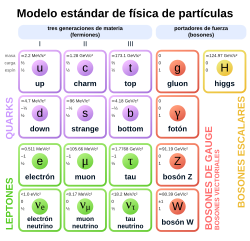Baryon
The baryons (from the Greek βαρύς, barys, “heavy”) are a family of subatomic particles made up of three quarks. The most representative, for forming the nucleus of the atom, are the neutron and the proton; but there is also another large number of baryons, although all of these are unstable. The name baryon is due to the fact that it was believed, when it was discovered, to have a greater mass than other particles.
Classification
Baryons are fermions affected by the strong nuclear interaction, so they are subject to the Pauli exclusion principle and can be described by Fermi-Dirac statistics. Unlike bosons, which do not satisfy the exclusion principle.
The bars belong, together with the Mesones, to the family of particles called hadrones, that is, those composed of quarks. They differ from the mesons because they are composed of three quarks, while the latter are composed of a quark and an antiquark. The quarks have a barionic number B=13{displaystyle B={1over 3}} and antiquarks B=− − 13{displaystyle B=-{1over 3}}. The existence of exotic bars such as pentaquarks, consisting of four quarks and an antiquark, has been proposed.B=13+13+13+13− − 13=1{displaystyle B={1 over 3}+{1 over 3}+{1 over 3}+{1 over 3}-{1 over 3}=1}).
Properties
Isospin and charge
The concept of isospin was proposed by Werner Heisenberg in 1932, explains the similarities between protons and neutrons under strong interaction. In 1964 Murray Gell-Mann proposed the quark model, with three types, the u, d and s. The quarks u and d has similar masses, therefore, the particles made of the same number, also have similar masses. The exact composition of the quarks u and d determines the load, as the quarks or carry the load 23{displaystyle {2 over 3}}while the quarks d carry the load − − 13{displaystyle}{1 over 3}}.
Types
Along with the proton and the neutron, within the family of baryons there are also the delta (Δ), lambda (Λ), sigma (Σ), xi (Ξ) and omega (Ω) particles.
The delta baryons (Δ++, Δ+, Δ0, Δ- ) are composed of up and down quarks, such that the total spin is 3/2. They decay into a pion and either a proton or a neutron.
The lambda baryons (Λ0) are composed of one up, one down, and one strange quark, with the up and down quarks in an isotopic spin state 0 (antisymmetric taste). The observation of the neutral lambda provided the first evidence of the strange quark. The lambda baryon almost always decays into a proton and a charged pion, or a neutron and a neutral pion.
The sigma baryons (Σ+, Σ0, Σ-) are also composed of a quark strange and the combination of one up and one down quark, but in a state of isotopic spin 1. Σ0 has the same quark structure as Λ0 (up, down, and strange), so its decay is much faster than the Σ+ (up, up, strange) and Σ- (down, down, strange).
The xi baryons (Ξ0, Ξ-) are composed of two strange quarks and one up or down quark. They generally decay into a pion and a lambda baryon, which itself decays as such. Due to this cascading sequence of decays, Ξ is also called a cascade particle (cascade particle).
The negative omega baryon (Ω-) is composed of three strange quarks. Its discovery represented a great advance in the study of quark processes, since only since then has its mass and disintegration been predicted.
Baryons composed of heavy quarks are coded by adding a subscript, which indicates that a strange quark can be replaced by a heavier one (eg: Λ+c is composed of charm quark, up and down; instead of up, down and strange).
Baryonic matter
The baryonic matter is that in whose mass baryons predominate, which can be formed by atoms of all kinds, and therefore, be almost any kind of matter. Its opposite is non-baryonic matter, which can be formed by neutrinos or free electrons, or even by strange species of non-baryonic dark matter, such as supersymmetric particles, axions or black holes.
The distinction between baryonic and non-baryonic matter is of particular importance in cosmology, since the amount of baryonic matter present in the early universe largely determines the patterns of nucleosynthesis produced in the Big Bang.
The mere existence of baryons is already a significant cosmological fact, since it is assumed that the Big Bang produced an equal amount of baryons and antibaryons. The process by which the number of baryons exceeds that of their antiparticles is called baryogenesis (analogous to the process of leptogenesis, by which the amount of matter formed by leptons exceeds its antimatter).
Contenido relacionado
Edme Mariotte
Unit of length
Boiling point







